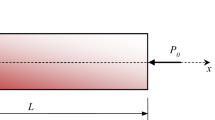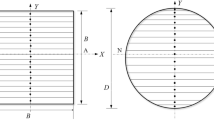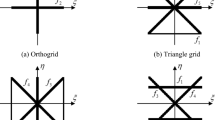Abstract
In this article, an extension of the well-known Saint-Venant solution for prismatic beams to tapered beams, i.e., straight beams with linearly varying cross-sections, is presented. The geometry of the tapered beam will be mapped to a reference constant beam, where the 3D equilibrium equations will be expressed, using a differential geometry framework. Then, the asymptotic expansion method will be used to solve these equations, leading to a series of hierarchical problems to solve. The final solution hence obtained is written as a combination of displacement and stress modes, which can be employed as a stress-recovery method for the tapered beam. It is proven in this work that the classical Saint-Venant solution is still valid for the tapered beam, but with the addition of correction modes, representing the effect of the taper.










Similar content being viewed by others
References
Argyridi, A.K., Sapountzakis, E.J.: Advanced analysis of arbitrarily shaped axially loaded beams including axial warping and distortion. Thin-Walled Struct. 134, 127–147 (2019)
Balduzzi, G., Hochreiner, G., Füssl, J.: Stress recovery from one dimensional models for tapered bi-symmetric thin-walled I beams: deficiencies in modern engineering tools and procedures. Thin-Walled Struct. 119, 934–945 (2017)
Bauchau, O.A., Han, S.: Three-dimensional beam theory for flexible multibody dynamics. J. Comput. Nonlinear Dyn. 9(4), 041011 (2014)
Bertolini, P., Eder, M.A., Taglialegne, L., Valvo, P.S.: Stresses in constant tapered beams with thin-walled rectangular and circular cross sections. Thin-Walled Struct. 137, 527–540 (2019)
Buannic, N., Cartraud, P.: Higher-order effective modeling of periodic heterogeneous beams. I. Asymptotic expansion method. Int. J. Solids Struct. 38(40), 7139–7161 (2001)
Carrera, E., Pagani, A., Petrolo, M., Zappino, E.: Recent developments on refined theories for beams with applications. Mech. Eng. Rev. 2(2), 00298 (2015)
Choi, S., Kim, Y.Y.: Consistent higher-order beam theory for thin-walled box beams using recursive analysis: membrane deformation under doubly symmetric loads. Eng. Struct. 197, 109430 (2019)
Ciarlet, P.G., Lods, V.: Asymptotic analysis of linearly elastic shells. I. Justification of membrane shell equations. Arch. Ration. Mech. Anal. 136(2), 119–161 (1996)
Cimetière, A., Geymonat, G., Le Dret, H., Raoult, A., Tutek, Z.: Asymptotic theory and analysis for displacements and stress distribution in nonlinear elastic straight slender rods. J. Elast. 19(2), 111–161 (1988)
Corre, G., Lebée, A., Sab, K., Ferradi, M.K., Cespedes, X.: Higher-order beam model with eigenstrains: theory and illustrations. J. Appl. Math. Mech. 98(7), 1040–1065 (2018)
Corre, G., Lebée, A., Sab, K., Ferradi, M.K., Cespedes, X.: The asymptotic expansion load decomposition elastoplastic beam model. Int. J. Numer. Methods Eng. 116(5), 308–331 (2018)
Corre, G., Lebée, A., Sab, K., Ferradi, M.K., Cespedes, X.: A new higher-order elastoplastic beam model for reinforced concrete. Meccanica 55(4), 791–813 (2020)
Demir, Ç., Civalek, Ö.: On the analysis of microbeams. Int. J. Eng. Sci. 121, 14–33 (2017)
El Fatmi, R., Ghazouani, N.: Higher order composite beam theory built on Saint-Venant’s solution. Part-I: theoretical developments. Compos. Struct. 93(2), 557–566 (2011)
Ferradi, M.K., Cespedes, X.: A curved beam model with the asymptotic expansion method. Eng. Struct. 241, 112494 (2021)
Ferradi, M.K., Lebée, A., Fliscounakis, A., Cespedes, X., Sab, K.: A model reduction technique for beam analysis with the asymptotic expansion method. Comput. Struct. 172, 11–28 (2016)
Hay, G.E.: The finite displacement of thin rods. Trans. Am. Math. Soc. 51(1), 65–102 (1942)
Hodges, D., Ho, J., Yu, W.: The effect of taper on section constants for in-plane deformation of an isotropic strip. J. Mech. Mater. Struct. 3(3), 425–440 (2008)
Hodges, D., Rajagopal, A., Ho, J., Yu, W.: Stress and strain recovery for the in-plane deformation of an isotropic tapered strip-beam. J. Mech. Mater. Struct. 5(6), 963–975 (2011)
Jog, C.S., Mokashi, I.S.: A finite element method for the Saint-Venant torsion and bending problems for prismatic beams. Comput. Struct. 135, 62–72 (2014)
Lebée, A., Sab, K.: A Bending-Gradient model for thick plates. Part I: theory. Int. J. Solids Struct. 48(20), 2878–2888 (2011)
Morandini, M.: Analysis of beam cross section response accounting for large strains and plasticity. Int. J. Solids Struct. 176, 150–172 (2019)
Morandini, M., Chierichetti, M., Mantegazza, P.: Characteristic behavior of prismatic anisotropic beam via generalized eigenvectors. Int. J. Solids Struct. 47(10), 1327–1337 (2010)
Numanoğlu, H.M., Akgöz, B., Civalek, Ö.: On dynamic analysis of nanorods. Int. J. Eng. Sci. 130, 33–50 (2018)
Trabucho, L., Viaño, J.M.: A new approach of Timoshenko’s beam theory by asymptotic expansion method. ESAIM: Math. Model. Numer. Anal. 24(5), 651–680 (1990)
Trabucho, L., Viano, J.M.: Mathematical modelling of rods. Handb. Numer. Anal. 4, 487–974 (1996)
Veiga, M.F.: Asymptotic method applied to a beam with a variable cross section. In: Asymptotic Methods for Elastic Structures, pp. 237–254. de Gruyter, Berlin (2011)
Yu, W., Hodges, D.H., Ho, J.C.: Variational asymptotic beam sectional analysis–an updated version. Int. J. Eng. Sci. 59, 40–64 (2012)
Author information
Authors and Affiliations
Corresponding author
Additional information
Publisher’s Note
Springer Nature remains neutral with regard to jurisdictional claims in published maps and institutional affiliations.
Appendices
Appendix 1
In this appendix, we demonstrate that the matrix \(\boldsymbol{A}\) defined in (71), is symmetric definite positive.
For the symmetry, only the demonstration of \(A_{34} = A_{43}\) is detailed, since it can be reproduced in the same way for the other necessary relations. By replacing \(\left ( \delta \boldsymbol{\sigma },\delta \boldsymbol{u} \right )\) in (63) with \(\left ( \boldsymbol{\Psi }_{\mathit{II}},\ \boldsymbol{0} \right )\) and in (64) with \(\left ( \boldsymbol{\Psi }_{I},\ \boldsymbol{0} \right )\), the following relations are obtained:
Using the symmetry of the elasticity tensor (\(C_{\mathit{ijkl}} = C_{\mathit{klij}} \)), we obtain \(A_{34} = A_{43}\). Following the same demonstration, it can be shown that the matrix \(\boldsymbol{A}\) can be expressed as follows:
To prove the definite positiveness of \(\boldsymbol{A}\), let us consider an arbitrary vector \(\boldsymbol{r}^{T} = \left \{ \begin{array}{c@{\quad }c@{\quad }c@{\quad }c} r_{1} & r_{2} & r_{3} & r_{4} \end{array} \right \} \neq \boldsymbol{0}\) and show that \(\boldsymbol{r}^{T} \boldsymbol{Ar}> 0\). The scalar \(\boldsymbol{r}^{T} \boldsymbol{Ar}\) is expressed as followed:
By noting \(s^{ij}:= \boldsymbol{r}^{T} \left \{ \begin{array}{c} \Psi _{I}^{ij}\\ \Psi _{\mathit{II}}^{ij}\\ \Psi _{\mathit{III}}^{ij}\\ \Psi _{\mathit{IV}}^{ij} \end{array} \right \} \), we obtain:
which concludes the demonstration.
Appendix 2
To prove the equation in (67): \(T_{(0)}^{\alpha } = \int _{S} \sigma _{(0)}^{\alpha 3} dS =0\), it is necessary to prove that for all the four stress modes \(\boldsymbol{\Psi }_{I,\dots ,\mathit{IV}}\) describing \(\boldsymbol{\sigma }_{(0)}\) in (62), we have:
The equation above will be proven only for the first stress mode, the same demonstration can be used for the others. To this aim, let us write the variational problem leading to \(\boldsymbol{\Psi }_{I}\):
By choosing \(\delta \boldsymbol{\sigma } =\boldsymbol{0}\) and \(\left ( \delta u_{1}, \delta u_{2}, \delta u_{3} \right ) = \left ( 0,0, X^{\alpha } \right )\), it is straightforward from the above equation that \(\int _{S} \Phi _{I}^{\alpha 3} \, dS =0\).
Rights and permissions
About this article
Cite this article
Ferradi, MK. The Saint-Venant Solution of a 3D Tapered Beam. J Elast 148, 1–25 (2022). https://doi.org/10.1007/s10659-021-09877-x
Received:
Accepted:
Published:
Issue Date:
DOI: https://doi.org/10.1007/s10659-021-09877-x




